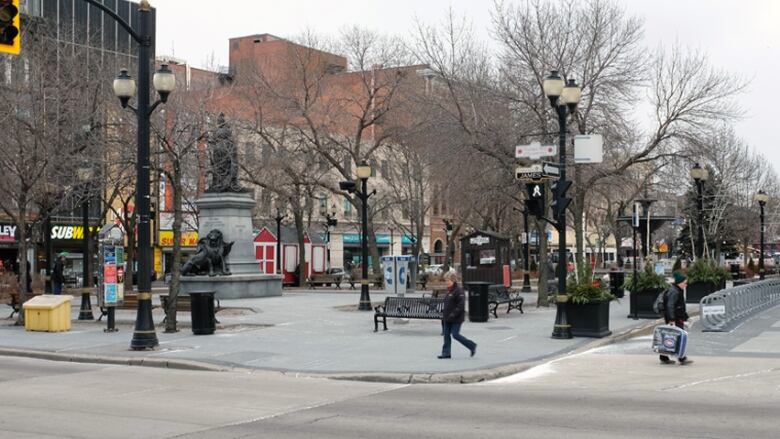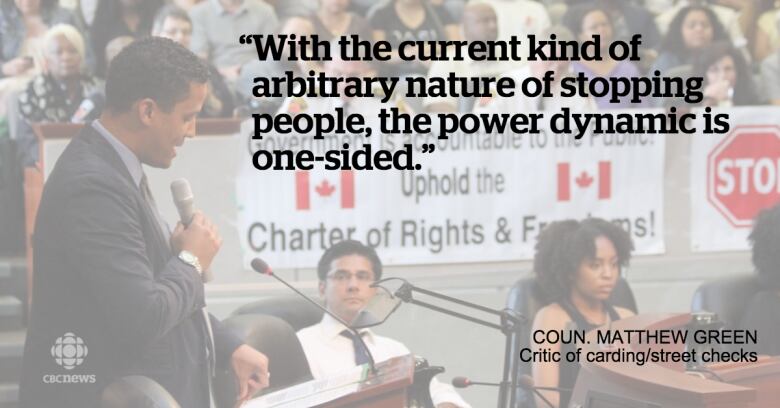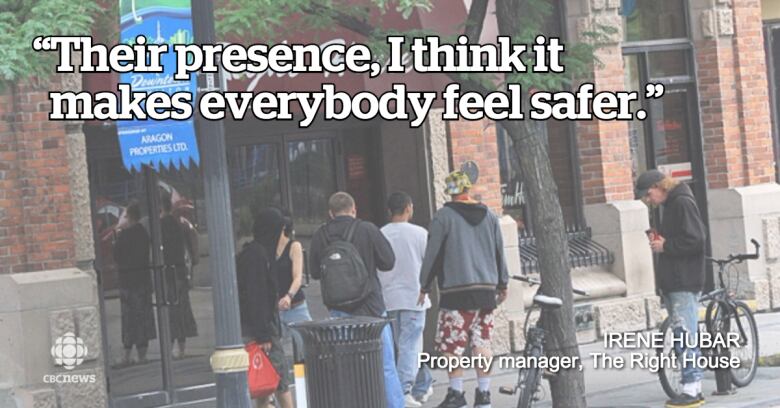Carding and 'cleaning up' the core: Hamilton's ACTION team
The ACTION team may be the place where evolving policing parameters are put to the test in Hamilton.

Part 2 of a CBC Hamilton examination of the Hamilton Police ACTION team and its future, given a number of big questions it facesabout its tactics, its metrics and an ongoing criminal case. Read part 1 here.
Hamilton Police's ACTION strategy is caught between demands to clean up downtownand the impact onpeople who are getting cleaned up.
The ACTION team interacts with people with mental illness, with addictions, with unstable shelter. Andone tool the yellow-jacketed officers rely on to keep tabs on the people moving in and through the core is"carding."
It's a combination that means theACTION strategy is at the centre of not only the local debate over police interactions with minorities and marginalized populations, but also the provincial overhaul of policing, carding and protecting minority rights.
- What is the future of Hamilton's ACTION team?
- DoHamilton Police actually card black people disproportionately?
- Hamilton police and emergency services street program 'navigates' the path back
Former chief Glenn DeCairemodeled Hamilton's ACTIONteam on hotspot anti-violence work he pioneered in Toronto. He's now left policing for a job atMcMaster, and the team faces big questions about its future, including thetools it uses to be proactive, like carding.
A city core has layers of stakeholders and constituencies. One of the most significant comprises the business owners and developers trying to reinvigorate a once-neglected downtown, who called for more policing late last decade.
Now, crime overall downtown is on a downward trajectory.
But advocates for vulnerable andmarginalizedpeople have ideas about how police should be downtown, too.
"Any first-world,21st-centurydowntown core no matter howgentrifiedor how polished up it may be is going to have to include people who are on the margins, who are poor or mentally ill, or old or low-income, however we describe it," said Paddy Bowen, the executive director of Mission Services, an organization that operates shelters and runs food and addictions programs.
'That's almost farcical'
The conversation about the future of ACTION will certainly include the future of street checks or carding.
The ACTION officers, including those on bikes, foot and horses, canstop people who may not have done anything wrong,ask them for ID and record information in their database.

Visible minorities arefar more likely than white peopleto be stopped multiple times in the same year, according to Hamilton Police statistics obtained by CBC News.
Though the black population measures 8 percent of the downtown population, black people made up between 11 and 14 per cent of Hamilton Policestreet checksbetween 2010 and 2014.
Coun. MatthewGreen, a critic of carding, said the tool undercuts the relationship-building the police say they're trying to do.
"As it stands now, with the current kind of arbitrary nature of stopping people, the power dynamic is one-sided," he said.
DeCairehas been an ardent defender of the practice and said thatHamilton will be less safe and crimes will go unsolved if the controversial tool is limited or abolished.
His strongly writtenjustification of street checks in a submission on proposed reforms to the practice garnered him a rebuke from the Ontario Human Rights Commission, which called his argument a case of 'textbook' racial profiling.
"That's almost farcical that through these kind of tactics the police could build community relations," said Price, the activist.
Between a dramaticfunding cut and the reforms coming to carding "taken together it's a messaging" that the province is going in a different direction, Price said.
But those in charge now, like Staff Sgt. ScottBalinson, mirror De Caire's view of it as integral, even though the province is reforming the practice withproposed new ruleslike telling someone he or she has the right to walk away if not under investigation.
"The challenge is very clear. We have responsibility to the community to be proactive," he said. "You're going to have conversations with many people in a wide range of contexts. The community has as much responsibility for setting the standard of what's acceptable."
'No matter how gentrified'
ACTION has lots of fans in the downtown business community, who've been wanting to see the core "cleaned up" for years. Police are more visible, said downtown property manager Irene Hubar in an interview with CBC News last fall.
"Their presence, I think it makes everybody feel safer," Hubar said.

"You have to have a safe neighbourhood for people who want to invest."
But enforcement alone doesn't address the root causes of vagrancy and homelessness, say advocates for marginalized people.
Worstersaid that's why the team grew to includethe Social Navigator program, which combines resources from the police, paramedics to try to connect "at-risk"people with supports.
But Bowen said she hopes the goal never becomes to "eliminate the quote-unquote 'problem' of the poor" downtown.
"I don't mind the allocation of the resources, I just don't want that the purpose is to 'clean up a problem,' rather than it being to support the evolution of a great city," she said.












_(720p).jpg)


 OFFICIAL HD MUSIC VIDEO.jpg)
.jpg)



























































































